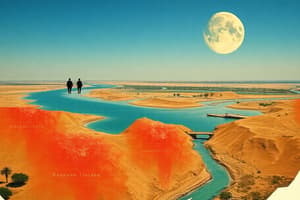Podcast
Questions and Answers
What are the primary branches of the Nile River?
What are the primary branches of the Nile River?
- Blue Nile and White Nile (correct)
- Red Nile and Green Nile
- Blue Sea and White Sea
- Nile Delta and Nile Brach
Why is the area around the Nile River crucial for agriculture?
Why is the area around the Nile River crucial for agriculture?
- It has abundant rainfall throughout the year.
- It provides significant freshwater for irrigation. (correct)
- Its volcanic soil is very fertile.
- It has a temperate climate suitable for all crops.
Which ancient civilization relied heavily on the Nile River for its livelihood?
Which ancient civilization relied heavily on the Nile River for its livelihood?
- The Mesopotamians
- The Roman Empire
- The Greek City-States
- The Ancient Egyptians (correct)
What kind of climate characterizes the region surrounding the Nile River?
What kind of climate characterizes the region surrounding the Nile River?
What is a significant issue faced by countries around the Nile River?
What is a significant issue faced by countries around the Nile River?
Flashcards are hidden until you start studying
Study Notes
Bahaging Hilaga o Lupain ng Ilog Nile
-
Heograpiya:
- Ang Ilog Nile ay ang pinakamahabang ilog sa mundo, umaabot ng humigit-kumulang 6,650 kilometro.
- Dumadaloy ito mula sa mga bundok sa silangang Africa patungong hilaga, at umaabot sa dagat Mediterranean.
-
Mga Bansa:
- Ang Ilog Nile ay dumadaan sa mga bansa tulad ng:
- Uganda
- Sudan
- Egypt
- Ang Ilog Nile ay dumadaan sa mga bansa tulad ng:
-
Mga Sanga:
- May dalawang pangunahing sangay ang Ilog Nile:
- White Nile (puting bahagi) – nagmumula sa Lake Victoria.
- Blue Nile (asul na bahagi) – nagmumula sa Ethiopian Highlands.
- May dalawang pangunahing sangay ang Ilog Nile:
-
Kahalagahan:
- Agrikultura: Ang mga lupain sa paligid ng Ilog Nile ay napakahalaga para sa pagsasaka, na nagbibigay ng tubig sa mga pananim.
- Sibilisasyon: Pinagmulan ng mga sinaunang sibilisasyon, kabilang ang sinaunang Ehipto, na umaasa sa mga banlaw ng ilog para sa kanilang kabuhayan.
-
Klima:
- Ang rehiyon ay may disyerto at subtropical na klima, na may mga tag-init na mainit at tuyo.
-
Ekosistema:
- Dami ng buhay-ilang at mga uri ng hayop at halaman na nakasalalay sa tubig mula sa Ilog Nile.
-
Mga Problema:
- Ang labis na paggamit ng tubig para sa irigasyon at iba pang layunin ay nagdudulot ng pag-aalala sa mga bansa sa paligid ng ilog.
- Pagkakaroon ng mga hidwaan sa pagitan ng mga bansa ukol sa karapatan sa tubig ng Ilog Nile.
-
Kulturang Panlipunan:
- Ang mga tao sa paligid ng Ilog Nile ay mayamang kultura na naiimpluwensyahan ng daloy ng ilog.
- Tradisyon, sining, at pagkain ay nakaugat sa kanilang koneksyon sa ilog.
Pangkalahatang Konklusyon
Ang Bahaging Hilaga o lupain kung saan dumadaloy ang Ilog Nile ay may malaking papel sa kasaysayan, kultura, at ekonomiya ng rehiyon. Ang pagsasaalaga at wastong pamamahala ng mga yaman mula sa ilog ay mahalaga para sa patuloy na pag-unlad ng mga bansang umaasa rito.
Geography
- The Nile River is the longest river in the world, approximately 6,650 kilometers long.
- It flows from the mountains in Eastern Africa northward to the Mediterranean Sea.
Countries
- The Nile River traverses several countries, including:
- Uganda
- Sudan
- Egypt
Branches
- The Nile has two main tributaries:
- White Nile: Originates from Lake Victoria.
- Blue Nile: Emerges from the Ethiopian Highlands.
Importance
- Agriculture: Surrounding lands are crucial for farming, providing water for crops.
- Civilization: It was the cradle of ancient civilizations, particularly Ancient Egypt, that relied on the river for livelihood.
Climate
- The region features a desert and subtropical climate, with hot and dry summers.
Ecosystem
- The Nile supports diverse wildlife and various species of plants and animals reliant on its waters.
Issues
- Overuse of water for irrigation raises concerns among neighboring countries.
- Conflicts have arisen regarding water rights among the nations relying on the Nile.
Cultural Aspects
- Communities along the Nile boast a rich culture heavily influenced by the river's flow.
- Traditions, arts, and cuisine are deeply connected to their relationship with the Nile.
General Conclusion
- The Northern region, where the Nile flows, plays a significant role in the history, culture, and economy of the area.
- Sustainable management of river resources is essential for the ongoing development of the countries that rely on it.
Studying That Suits You
Use AI to generate personalized quizzes and flashcards to suit your learning preferences.




